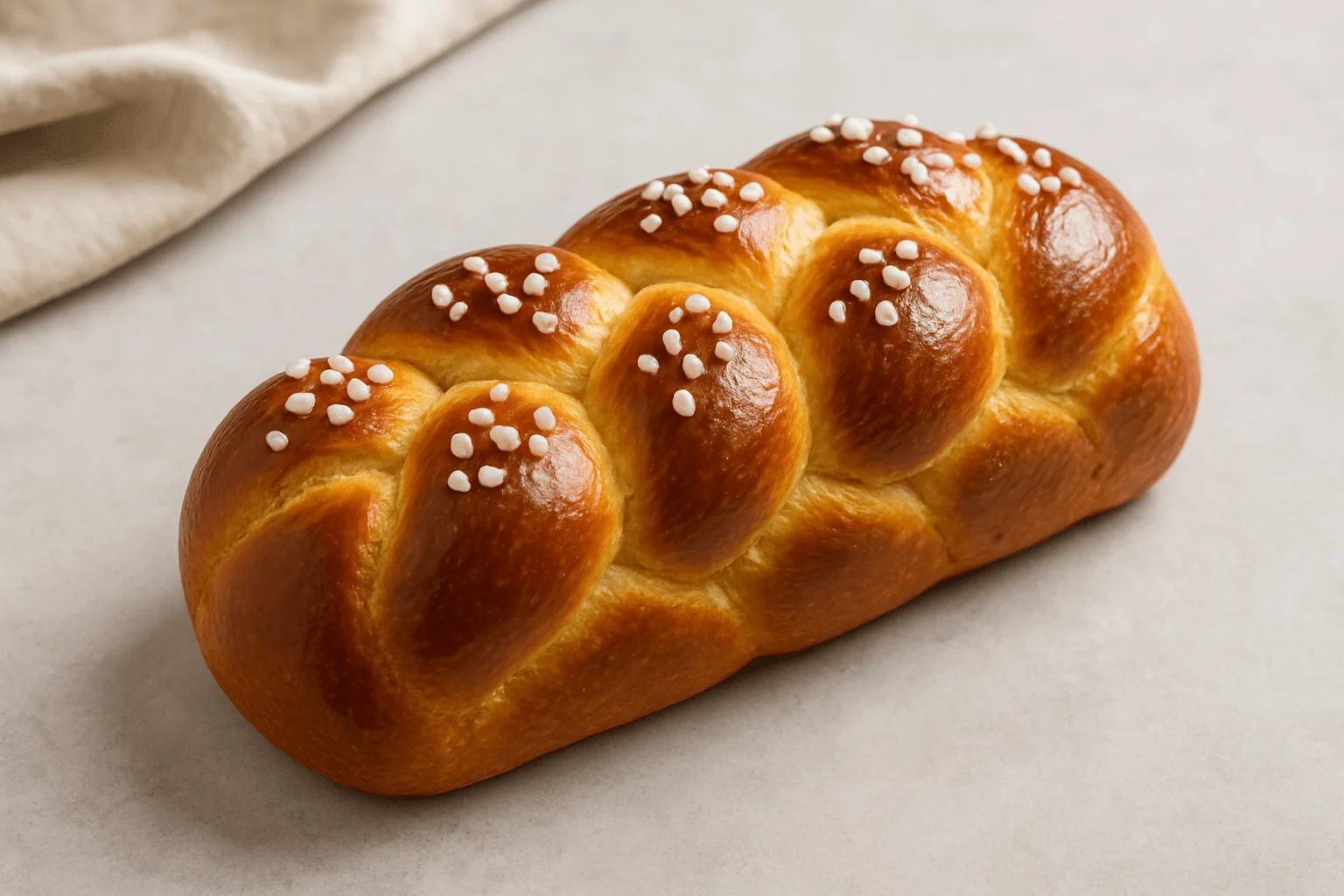braided brioche recipe
There’s a certain kind of magic woven into the strands of a braided brioche. Soft, rich, and golden, it’s more than a loaf — it’s a celebration of craftsmanship and comfort. From the first glance, its glossy, burnished surface and intricate braids promise something special. And once sliced, it delivers: featherlight texture, a tender crumb, and a taste that feels like home.
Braided brioche is where technical skill meets poetry. Each strand of dough is shaped with care, rolled to perfection, then woven in a dance of symmetry and softness. It’s a slow process, yes — one that demands patience and a gentle hand — but that time and intention are precisely what give the final result its signature beauty and flavor.
The loaf rises once, then again, and finally bakes into a golden masterpiece. When it emerges from the oven, it fills the kitchen with the unmistakable aroma of sweet butter and warmth. The crust glows with a delicate sheen, the result of a simple glaze brushed on just before baking. But its allure is not just in appearance — the first bite is pure delicacy. Slightly sweet, incredibly airy, and meltingly soft, each mouthful speaks of Sunday mornings, family gatherings, and timeless tradition.
Braided brioche is a chameleon, too. It pairs as effortlessly with a dollop of jam at breakfast as it does with a sliver of cheese or a touch of chocolate. It’s as fitting for a holiday table as it is for an everyday indulgence. It may look intricate, but at its heart, it is a bread of generosity — one that’s meant to be shared, enjoyed, and remembered.
Link to your classic brioche à tête recipe
Anchor text: Also learn how to master the classic brioche à tête like a pro
URL suggestion:https://briochechic.com/classic-brioche-a-tete-recipe
This is not just baking. This is a quiet ritual. A moment of stillness. A tribute to the slow and the beautiful.
Braided Brioche
Serves: 4 to 6 people
Preparation Time: 45 minutes
First Rest (Bulk Fermentation): 30 minutes
Chilling Time: At least 2 hours
Final Proofing (Second Rise): 2 hours
Baking Time: 20–25 minutes, depending on weight
Storage: Keeps well for up to 48 hours at room temperature, ideally wrapped or under a dome
You Will Need:
Dough
– 300 g of brioche dough
Egg Wash
– 25 g whole egg
– 20 g egg yolk
– 25 g whole milk
Finishing Touch
– Pearl sugar, as needed, for garnish
Recommended Tools:
– Stand mixer
– Bowl scraper
– Dough cutter
– Pastry brush
Step-by-Step Braided Brioche Recipe
- To begin, divide the chilled brioche dough into three equal portions using a dough cutter. The image captures a beautifully baked braided brioche loaf resting on a lightly textured surface. Its golden-brown crust glistens under soft, natural lighting, with sugar pearls delicately scattered over the top, adding a touch of sparkle and sweetness. Each strand of the braid is clearly defined, revealing the baker’s precision and technique..
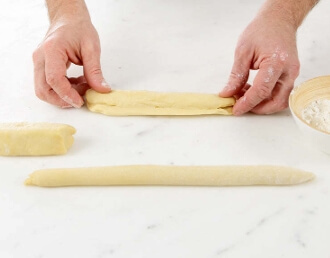
- Lightly flour the brioche logs and place them side by side on your work surface. Braid the logs together by pinching the top ends to seal them and then alternating the strands: cross the right strand over the center, followed by the left strand over the new center, repeating this sequence until you reach the ends. Gently press the ends together and tuck them underneath to seal the braid.
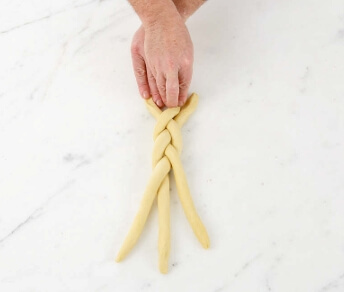
- Brush the loaf with an egg wash, then proof it for about 2 hours at around 26°C (or in an off oven with a bowl of boiling water placed inside), allowing it to at least double in size. Once proofed, sprinkle the top with pearl sugar and bake the brioche at 170°C (350°F, gas mark 5/6) for about 20 minutes.Link to your
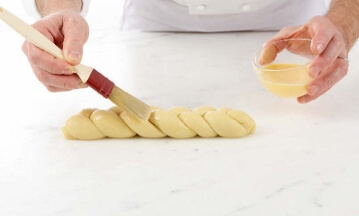
- After baking, transfer the brioche to a cooling rack to let it rest and cool slightly before serving.
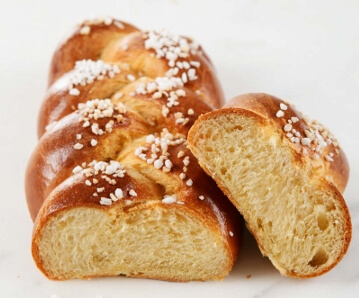
Conclusion: The Art of Braided Brioche – A Rewarding Experience
Baking braided brioche is more than just following a recipe; it’s about immersing yourself in the process, allowing time to knead, rest, braid, and bake. The result isn’t just a loaf of bread — it’s a delicate masterpiece that fills your kitchen with the heavenly aroma of butter, sweetness, and freshly baked dough. The intricate braiding, the golden finish, and the soft, airy crumb come together in perfect harmony, offering not just a delicious treat, but also a sense of accomplishment.
While it may seem like a long process, each step is essential for creating that perfect, soft texture and a crisp golden crust. So, take your time, savor the moment, and enjoy the journey of creating something truly extraordinary. Whether you’re baking for a family gathering, a special occasion, or simply because you love the art of baking, a braided brioche will never disappoint
King Arthur Baking – Classic Brioche Recipe
Anchor text: See the traditional method at King Arthur Baking
URL:
https://www.kingarthurbaking.com/recipes/brioche-recipe
Now, as with any craft, there are always questions, and I’m here to help guide you through!
Q&A: Common Questions About Braided Brioche
Q: What should I do if my brioche dough is too sticky?
A: If your dough feels sticky and hard to handle, don’t worry! It’s important to let it rest for a little while as brioche dough needs time to absorb all the flour and butter properly. You can also lightly flour your hands and work surface to help with handling. If it’s still too sticky, add just a touch more flour, but be careful not to overdo it, as too much flour can make your brioche dense.
Q: Can I freeze braided brioche?
A: Yes! Braided brioche freezes beautifully. Once baked and cooled, wrap it tightly in plastic wrap or foil, and store it in an airtight bag or container. It can be frozen for up to 3 months. To reheat, simply thaw it at room temperature and warm it up in the oven for a few minutes for that fresh-baked taste.
Q: How do I know when my brioche is properly proofed?
A: Proper proofing is crucial to achieving that light, airy texture. You’ll know the dough is ready when it has roughly doubled in size and feels soft to the touch. You can perform the “poke test” by gently pressing your finger into the dough; if the indentation remains and doesn’t spring back, it’s ready for baking.
Q: Can I add different flavors to my brioche?
A: Absolutely! Brioche is a versatile dough that can be flavored in many ways. Try adding a bit of citrus zest for a refreshing twist, or fold in some cinnamon, vanilla, or chocolate for a more indulgent treat. The dough can also be enriched with fruits like raisins or chocolate chips for a fun variation.

